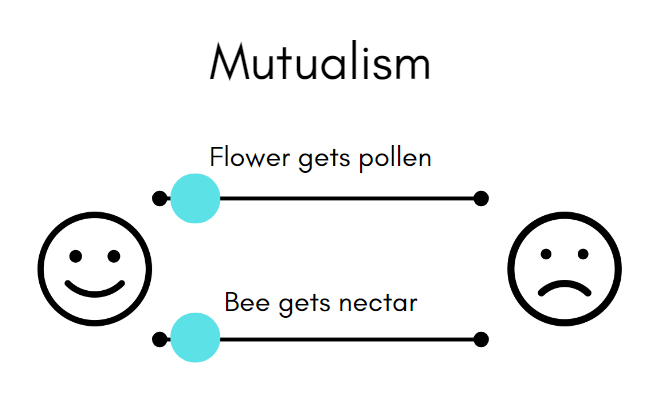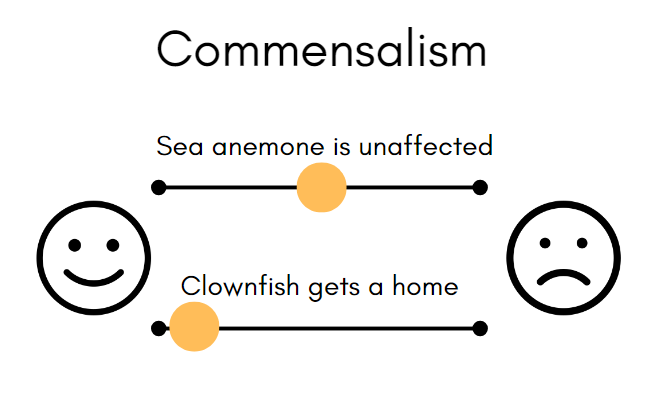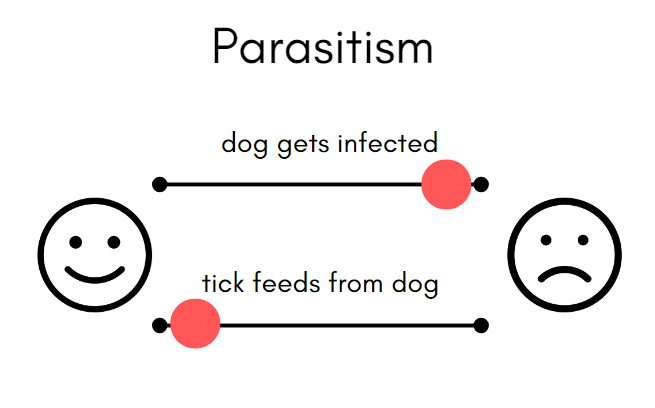Biology Semester 2 Study Guide
Unit 4: Genetics
Concept 1: DNA Structure and Replication
Vocabulary
Nucleic Acid: macromolecule that holds genetic information
Nucleotide: monomer of nucleic acid (made of sugar, phosphate, and nitrogen base)
Chromosome: tightly coiled strands of DNA
Gene: a section of DNA that has instructions to code for a protein
Objectives
1. DNA vs RNA
DNA has:
a double helix structure
Adenine, Thymine, Guanine, and Cytosine
sugar = deoxyribose
Deoxyribonucleic acid
RNA has:
a single strand structure
Adenine, Uracil, Guanine, and Cytosine
sugar = ribose
Ribonucleic acid
2. Base pairing rule
Adenine ALWAYS pairs with Thymine in DNA
In RNA, Adenine pairs with Uracil
Guanine ALWAYS pairs with Cytosine in DNA
3. Structure of a nucleotide
Phosphate, sugar, and nitrogen base
Phosphate and sugar are connected by a strong covalent bond
Sugar and nitrogen base are connected by a strong covalent bond
The nitrogen bases from each side connect in the middle by a weak hydrogen bond
4. DNA replication
A cell always needs to replicate it’s DNA before it divides
Steps:
1. An enzyme unzips the DNA
2. Free complementary bases in the nucleus match up with each side on the unzipped DNA
3. Two identical DNA molecules are formed
5. DNA replication = semi conservative
DNA is considered semi-conservative
the original strand is part of each new strand
half of the original DNA is in each of the new strands
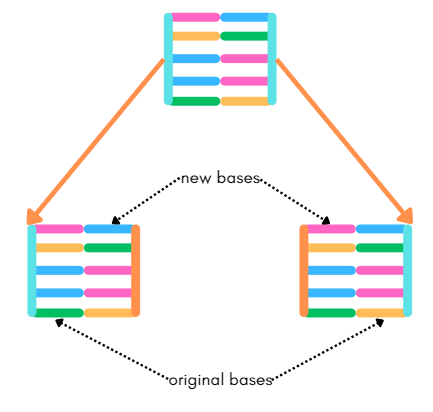
Concept 2: Protein Synthesis
Vocabulary
Protein synthesis: the process of reading the instructions in DNA to make a polypeptide
Polypeptide: a chain of amino acids; can bind to others and fold into a protein
Transcription: when DNA is copied into a complementary strand
Genetic code: code of instructions for how to make proteins
Codon: a set of three nucleotides on the mRNA
Anticodon: “complementary” three nucleotides on the tRNA
Amino Acid: monomer for making proteins, held together by peptide bonds
Translation: the process of interpreting RNA into a protein
Epigenetics: the study of changes in gene expression that are heritable
Objectives
1. The Central Dogma

DNA —transcription—> mRNA —translation—> protein
It needs to be a two step process
the info in DNA needs to get to the ribosomes
but DNA can’t leave the nucleus
so mRNA is used as a messenger
2. Roles of they 3 types of RNA
There are 3 types of RNA
mRNA
the messenger that brings the genetic information from the nucleus to the ribosomes
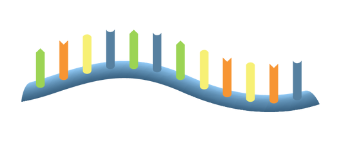
tRNA
what transfers the amino acids to the ribosomes where the proteins are made
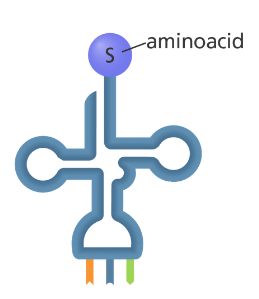
rRNA
the ribosomes where the proteins are made

3. Transcription
Purpose: get the information on the DNA to the mRNA
Occurs in: the nucleus
Steps:
1. DNA unzips
2. Free nucleotides bind to one side of the DNA to form mRNA
3. mRNA detaches from the DNA
4. mRNA leaves the nucleus
5. DNA zips back up
Example:
DNA: TAC | ACC | GGA | GCG | TTT | ATT
mRNA: AUG | UGG | CCU | CGC | AAA | UAA

4. Translation
Purpose: give the information from the mRNA to the tRNA to make a protein
Occurs in: the ribosomes
Steps:
1. tRNA has anticodons that match with each codon
2. each anticodon corresponds to a amino acid
3. the tRNA reads the mRNA and drops off the correct amino acids in order to create a protein chain
Example:
DNA: TAC | ACC | GGA | GCG | TTT | ATT
mRNA: AUG | UGG | CCU | CGC | AAA | UAA
tRNA: UAC | ACC | GGA | GCG | UUU | AUU
amino acids: met - try - pro - arg - lys - stop
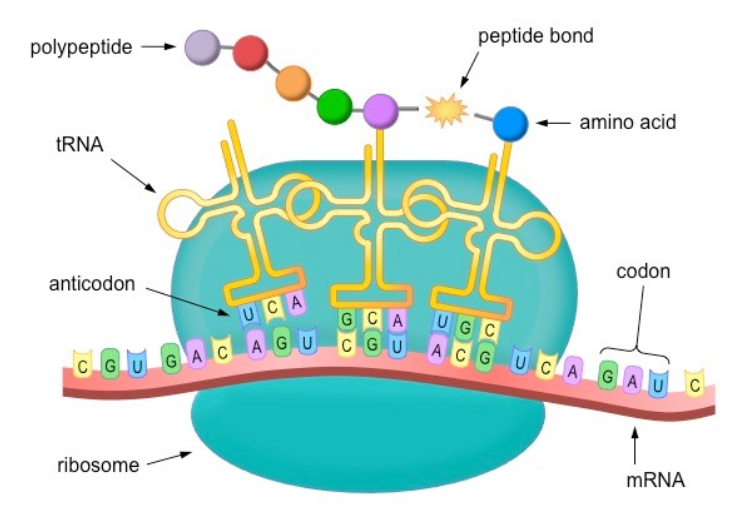
5. Gene Regulation
a highly regulated process
turns genes ‘on’ and ‘off’
this is critical for cell differentiation
Some genes are expressed, so they make the proteins they code for
Some genes are turned ‘off’, they do not make the proteins they code for
Regulatory proteins turn genes ‘on’ or ‘off’
Example:
Eye color
You may have a blue eye gene and a brown eye gene, but only one of them will be regulated
So only one will show up- the one not turned ‘off’
6. Epigenetics vs Mutation
Epigenetics- the study of changes in genes that are heritable
does not affect the DNA sequence
just a change in how the gene is expressed
Concept 3: Meiosis
Vocabulary
diploid: cell with 2 full sets of chromosomes
haploid: cell with 1 full set of chromosomes
karyotype: a diagram that shows the number and visual appearance of the chromosomes in a cell
meiosis:
sexual reproduction:
fertilization:
homologous chromosomes:
sister chromatids:
Objectives
1. Somatic Cells vs Gametes
Somatic Cells are body cells
they have 2 full sets of chromosomes
Gametes are sex cells
they have 1 full chromosome set
2. Autosomes vs Sex Chromosomes
Autosomes
carry traits that make you who you are
Sex Chromosomes
carry traits that determine your biological sex
3. Meiosis Happens Twice
cells MUST go through meiosis division twice
gametes need to be haploid
WHY?
when an egg and sperm meet in fertilization, their DNA combines to make one offspring
so each egg and sperm needs to only have half the number of chromosomes so the offspring has the correct number
4. Purpose of Meiosis I vs Meiosis 2
Meiosis 1: separate the homologous chromosomes
Meiosis 2: separate the sister chromatids
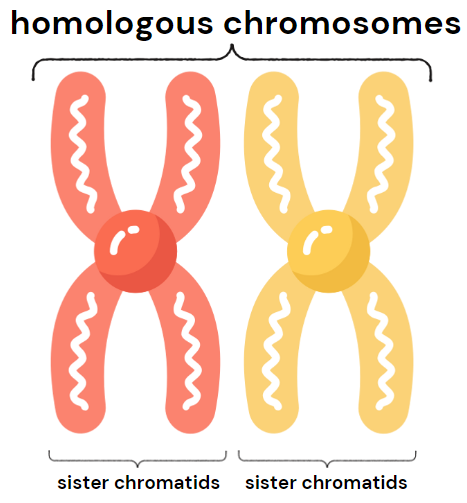
5. Crossing Over
crossing over is when genetic information swaps between homologous chromosomes
this makes each daughter cell unique
6. Stages of Meiosis
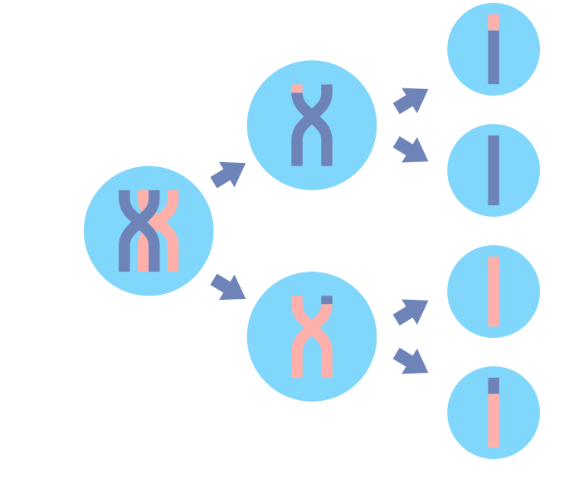
Meiosis I
Prophase I
homologous chromosomes pair up
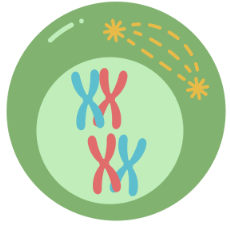
Metaphase I
spindle fibers attach to the centromeres
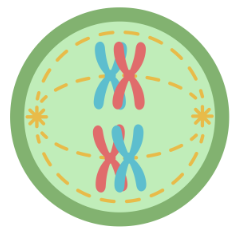
Anaphase I
chromosomes are pulled apart
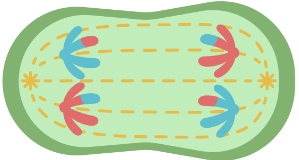
Telophase I
spindle fibers disappear
cell starts to split
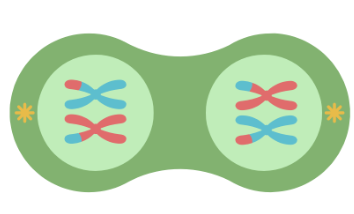
Meiosis II
Prophase II
spindle fibers appear and nuclear membranes break down
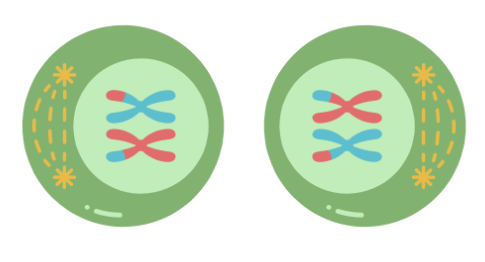
Metaphase II
spindle fibers attach to the centromeres
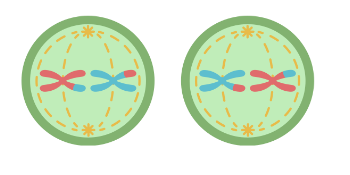
Anaphase II
spindle fibers pull the sister chromatids apart

Telophase II
nuclear membranes reform
cell starts to split in two
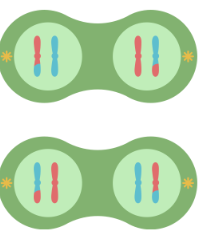
7. Meiosis vs Mitosis
Mitosis
creates: 2 diploid, identical daughter cells
purpose: growth and repair
when does it happen: throughout life
type of reproduction: asexual
Meiosis:
creates: 4 haploid, unique daughter cells
purpose: creating gametes
when does it happen:
males: throughout life
females: before birth
type of reproduction: sexual
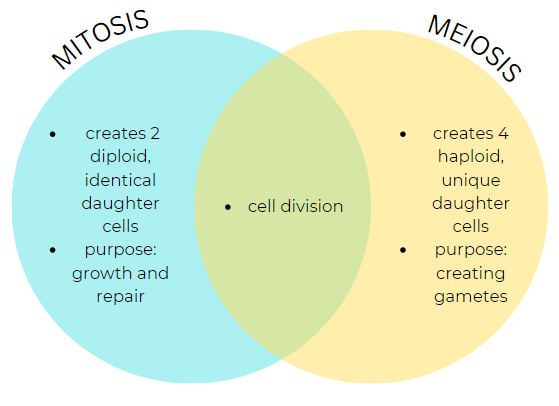
8. Mistakes in Meiosis vs Mitosis
Mitosis:
a mistake in mitosis creates a mutation that could cause the wrong proteins to me made
it leads to cancer sometimes
Meiosis:
a mistake in meiosis creates a mutation that causes offspring to have too few or too many chromosomes
Unit 5: Heredity
Concept 1: Mendelian Genetics
Vocabulary
genes: sections of DNA code for a protein
alleles: different versions of the same gene
homologous chromosomes: the matching chromosomes from our mom and dad
homozygous: 2 of the SAME alleles
heterozygous: 2 DIFFERENT alleles
dominant: if present, the allele will always have that trait expressed
recessive: the allele will only be expressed when the dominant allele is NOT present
genotype: the actual alleles inherited
phenotype: the physical traits
Punnett square: a diagram that shows the probability of inheriting traits from parents with certain genes
monohybrid cross: a cross between two organisms looking at one trait
dihybrid cross: a cross between two organisms looking at two different traits
Objectives
1. Mendel’s experiments and laws
Mendel crossed pea plants with different traits to see what their offspring would be like
from his research, he came up with 3 Laws of Inheritance
1. Law of Dominance: dominant alleles always show over recessive alleles
2. Law of Segregation: each gamete only receives one chromosome from each pair
3. Law of Independent Assortment: the assortment of chromosomes for one trait doesn’t affect the assortment of chromosomes for another trait
2. Monohybrid crosses
monohybrid cross: a cross between two organisms looking at one trait
phenotypic ratio: the ratio of different phenotype possibilities
genotypic ratio: the ratio of different genotype possibilities
Example:
B = brown eyes
b = blue eyes
Anna has brown eyes, but only her mom had brown eyes. David has blue eyes. Find the phenotypic ratio and the genotypic ratio.
phenotypic ratio: ½ = brown, ½ = blue
1 : 1
genotypic ratio: ½ = Bb, ½ = bb
1 : 1
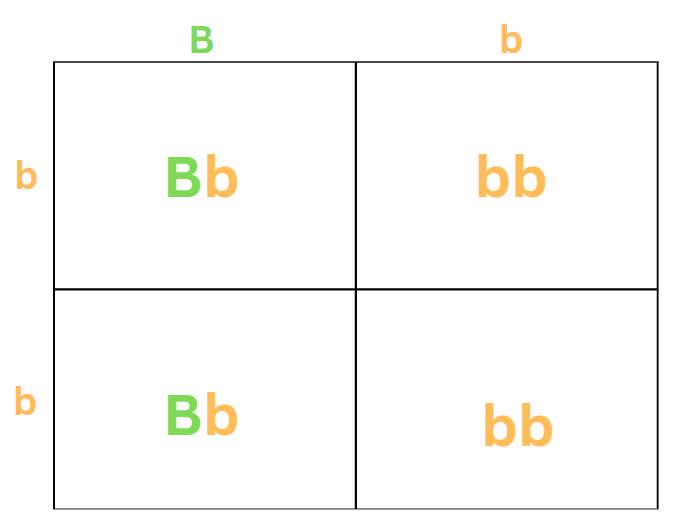
3. Dihybrid crosses
dihybrid cross: a cross between two organisms looking at two different traits
Example:
B = brown eyes
b = blue eyes
Anna has brown hair and brown eyes, but her dad was blonde and blue eyed. David has brown hair and brown eyes, but her mom was blonde and blue eyed.
phenotypic ratio: 9/16 = brown/brown, 3/16 = brown/blonde, 1/16 = blue/blonde, 3/16 = blue/brown
9 : 3 : 3 : 1
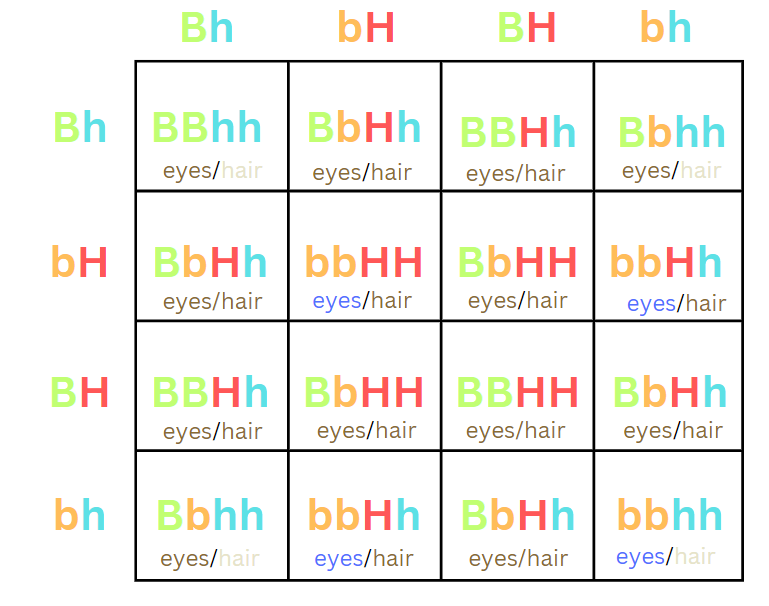
Concept 2: Complex Inheritance Patterns
Vocabulary
chromosome theory of inheritance: genes are located on chromosomes and the behavior of chromosomes during meiosis accounts for inheritance patterns
epistasis: when one gene overshadows all the others and controls whether they are expressed
carrier: someone how carries a recessive gene
Objectives
1. Incomplete dominance vs codominance
incomplete dominance:
when both alleles are dominant
they mix when the genotype is heterozygous
Example:
A red flower and a white flower are crossed to make pink flowers
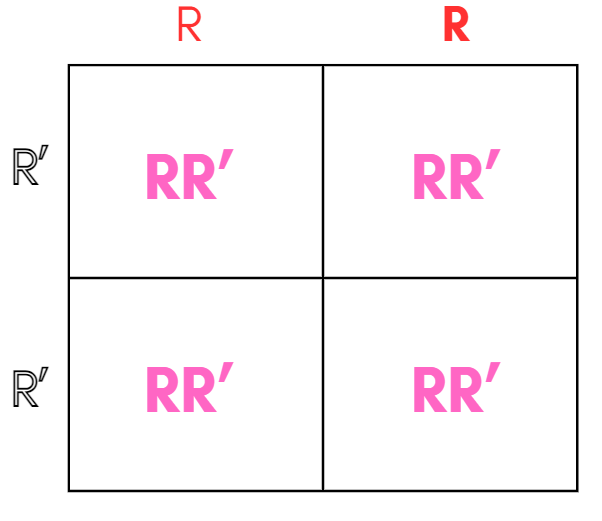
codominance
when both alleles are dominant
they both show completely and separately
Example:
A white horse and an brown horse are crossed to make an appaloosa horse
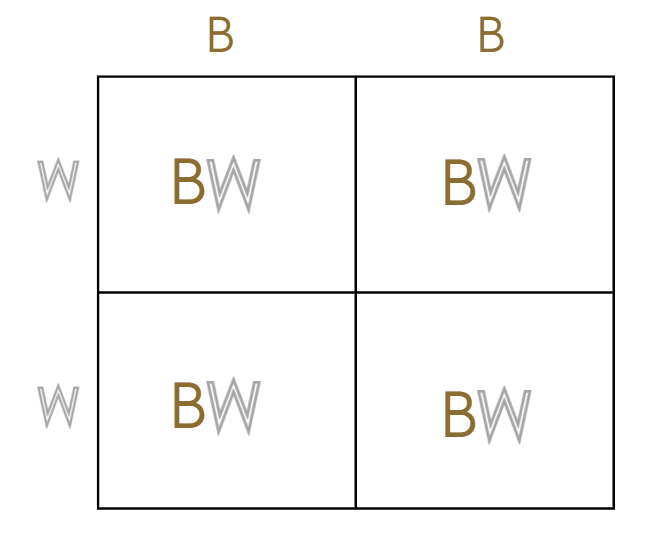
2. Multiple alleles vs polygenic traits
Multiple alleles
traits that are only on one gene
there are many different alleles of that trait
Example:
fur color in rabbits
Polygenic traits
traits that are decided by multiple genes
Example:
eye color
3. Blood Type Example
blood type has 4 different alleles, so it is an example of multiple alleles
the A and B blood types form AB, so it is an example of codominance
4. Linked genes vs sex link traits
Linked Genes
close together
more likely to be passed down together
Sex linked traits
linked to one of the sex chromosomes
X-linked traits
women need both to get the trait (XX)
men only need one to get the trait (XY)
Y-linked traits
women never get them (XX)
men only need one to get the trait (XY)
5. Traits on sex chromosomes vs autosomes
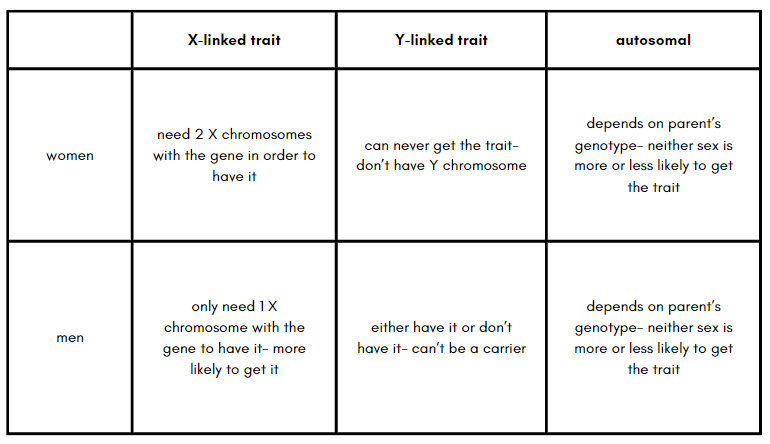
Concept 3: Mutations and Pedigrees
Vocabulary
mutation: any change in DNA
mutagen: chemicals that can cause DNA mutations
duplication: a mutation that changes the size of the chromosomes and results in multiple copiers of the same gene
translocation: a mutation that causes pieces of non-homologous chromosomes to exchange segments
nondisjunction: a mutation that happens when chromosomes don’t separate correctly during meiosis, resulting in 1 or 3 chromosomes in a group, rather than 2
pedigree: a chart used to trace the phenotypes and genotypes in a family to determine whether people carry traits
Objectives
1. Somatic mutations vs germline mutations
somatic mutations
occur in body cells
cause cancer
germline mutations
occur in germ line cells (before meiosis)
cause mutated gametes
resulting in mutated offspring
2. Gene vs chromosomal mutation
gene mutations
cause a change in the DNA sequence
occur during DNA replication
chromosome mutations
occur during mitosis
cause a change in the number/location of the genes
3. Point mutations vs frameshift mutation
point mutations
happen when one nucleotide is substituted for another
frameshift mutations
happen when a nucleotide is deleted or added, causing everything after it to be wrong
4. Types of Inheritance Patterns
1. Autosomal Recessive
trait is a rare, recessive trait that often skips a generation
Example:
cystic fibrosis
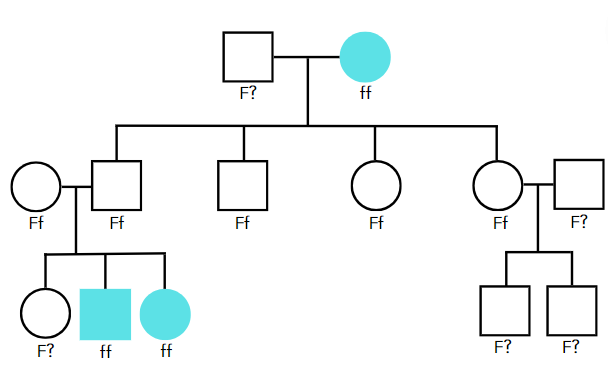
2. Autosomal Dominant
trait is a very common, dominant trait that will never skip a generation
Example:
Huntington’s
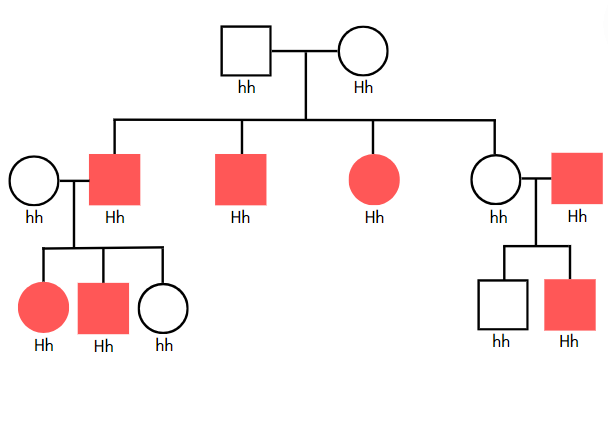
3. Sex-linked recessive
trait is linked to the X chromosome
boys are more likely than girls to get it
it skips generations
Example:
color blindness
Concept 4: Genetic Engineering
Vocabulary
biotechnology: refers to any technology used to the change genetic makeup of living things to make products
genetic engineering: the direct manipulation of an organism’s genome using biotechnology
recombinant DNA: artificially made DNA from 2 or more different sources
genome: an organisms complete set of DNA; all its genes
gene map: shows the location of genes on a chromosome
polymerase chain reaction: a technique that allows you to copy a piece of DNA without a cell
gel electrophoresis: a laboratory method that used an electrical current to separate DNA fragments based on their molecular size
gene cloning: produces identical copies of a gene
CRISPR: a gene editing technique that can delete, insert, or repair genes
selective breeding: artificially breeding organisms with a desired trait
pharming: producing pharmaceuticals in farm animals or plants
Objectives
1. Goal of genetic engineering
The goals of genetic engineering are:
to alter an organism’s genome
to create products by doing this (antibiotics, vaccines, synthetic hormones, biofuels)
to ensure an organism and it’s offspring have a desired trait (creatin the ‘perfect’ organism)
2. Examples of genetic engineering
Gene cloning:
produces identical copies of a gene (or genome)
Gene therapy
CRISPR
a gene editing technique that can delete, insert, or repair
Selective Breeding
artificially breeding organisms with a desired trait
how ‘pharm’ animals are mare
pharming: producing pharmaceuticals in farm animals or plants
Unit 6: Ecology
Concept 1: Intro to Ecology
Vocabulary
Ecology: the study of relationship between organisms and between an organism and it’s environment
Metabolism: all the chemical reactions of each cell in an organism that provide energy for life’s processes and create key molecules
Organism: an individual member of a species or population
Population: multiple organisms of the same species living together
Community: multiple populations of different species living together
Ecosystem: community plus all abiotic factors in the environment
Biome: multiple ecosystems that share similar characteristics but are located in different areas
Biosphere: the zone of life on Earth, encompassing all of Earth’s ecosystems
Biodiversity: the variety of organisms considered at all levels
Taxonomy: field of biology that classifies organisms, organizing them based on characteristics
Binomial nomenclature: 2 name naming system that names organisms after their two most specific classification levels
Dichotomous key: tool used for identifying organisms based on their characteristics
Objectives
1. Characteristics of life
Made of cells
Have a metabolism
Reproduce
Grow/develop
Respond to stimuli
Adapt and evolve
Contain DNA/RNA
2. Sexual vs asexual reproduction
Sexual Reproduction:
two parents produce a genetically unique offspring
Asexual Reproduction:
one parent produces a genetically identical offspring
3. Stimulus and Response
Stimulus:
temperature increases
Response
organism sweats and finds shade
4. Levels of ecological organization
Biosphere
Biome
Ecosystem
Community
Population
Organism
5. Levels of taxonomy
Domain
Kingdom
Phylum
Class
Order
Family
Genus
Species
Concept 2: Biogeochemical Cycles
Vocabulary
Biogeochemical cycles: represent the movement of a particular form of matter through the living and non-living parts of an ecosystem
Aquifer: the layer of permeable rock underground that can hold water
Eutrophication: when a body of water becomes overly enriched in nutrients
Objectives
1. Matter must cycle
Matter must cycle because there is a fixed amount of each element in the world, we can’t make more, so matter needs to cycle so all living things can use it how they need to
2. The water cycle

3. The carbon cycle
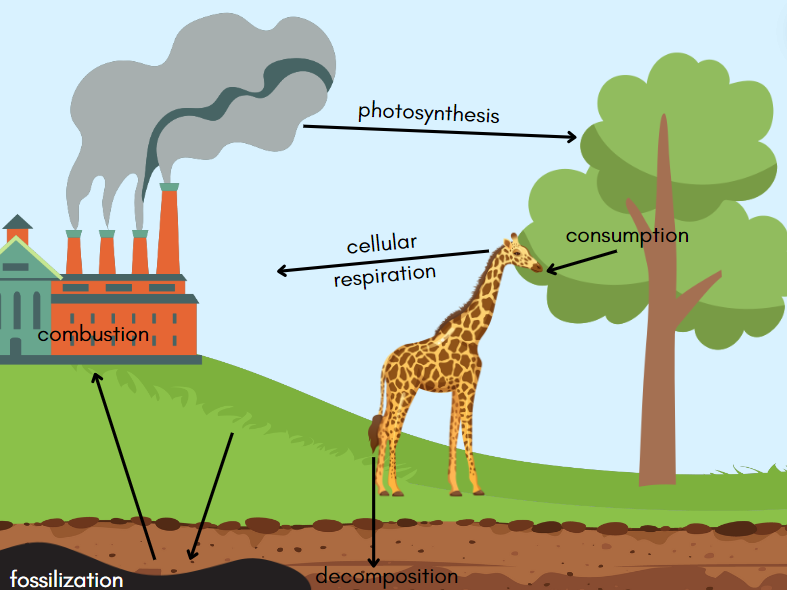
4. The nitrogen cycle
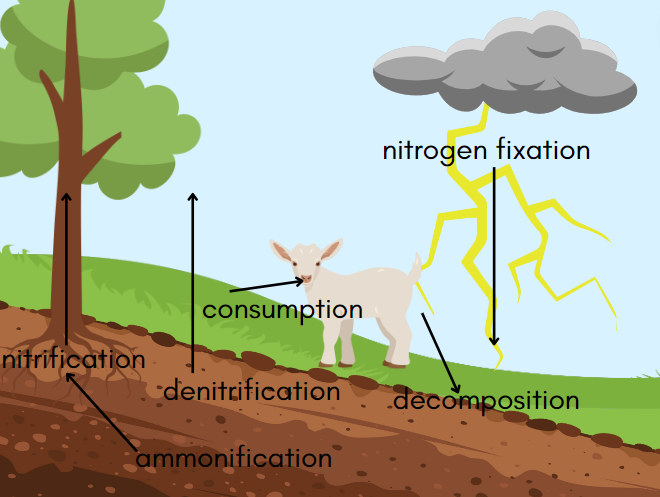
5. Impact of human and non-human organisms
Water cycle:
Human: deforestation causes transpiration
Non-Human: plants transpirate water out of their leaves
Carbon Cycle:
Human: Humans burn fossil fuels, releasing carbon into the atmosphere
Non-Human: animals eat plants, consuming carbon
Nitrogen Cycle
Human: Humans fertilize plants, releasing too much nitrogen into the soil
Non-Human: plants take in nitrates and nitrites through their roots
Concept 3: Population Ecology
Vocabulary
Population: a group of organisms of the same species living in the same place
Population density: measures the number of individual organisms living in a defined space
Survivorship curve: a graphic representation of mortality patterns
Exponential growth: population grows without limits
Logistic growth: population grown quickly at first, then levels off
Carrying capacity: the max population a society can support
Limiting factors: aspects of an environment that limit the size of a population
Biotic: living
Abiotic: non-living
Density-dependent: have a bigger impact on more dense populations
Density-independent: regulate population growth regardless of size and density
Objectives
1. High population density vs low population density
High Density:
causes: abundant resources, immigration, high birth rate, low death rate
Low Density:
causes: few resources, emigration, low birth rate, high death rate
2. Logistic vs exponential population growth
Logistic Growth:
can only support so much; population will stop growing after a point
Exponential:
doesn’t stop growing; no limit
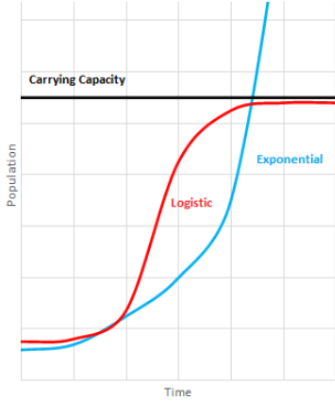
3. Survivorship curves
Type I: late loss, few offspring, heavy parental care (ex: humans)
Type II: constant loss, unaffected by age (ex: birds)
Type III: early loss, many offspring, low parental care (ex: reptiles)
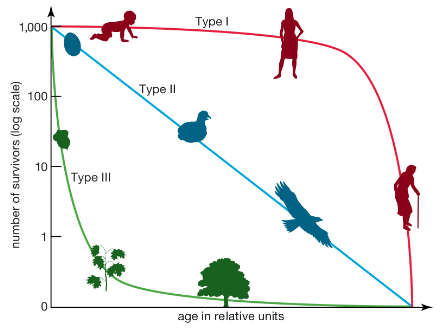
4. Types of dispersion patterns
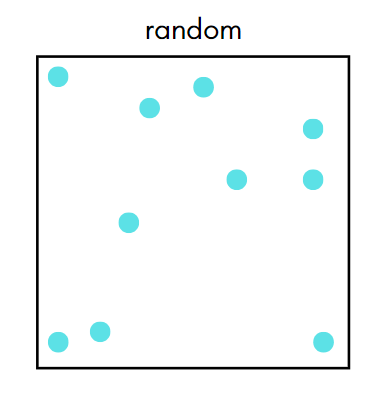
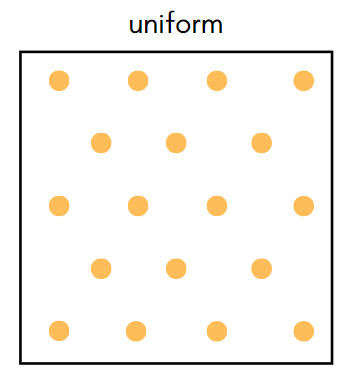
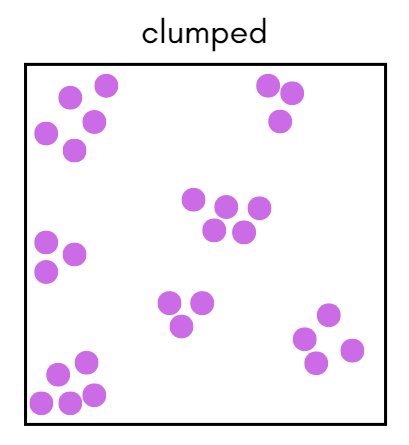
5. Limiting factors

Concept 4: Human Impact
Vocabulary
Sustainability: a balance between Earth’s resources, human needs, and the needs of other species
Ecological (carbon) footprint: the amount of carbon emitted and its environmental impact
Greenhouse effect: the normal warming effect when gases trap heat in the atmosphere
Invasive species: non-native species introduced to an ecosystem that negatively harms
Objectives
1. Human impact of biogeochemical cycles
Water cycle:
deforestation decreases transpiration
Carbon cycle:
we burn fossil fuels, releasing CO2
Nitrogen cycle:
fertilizers release too much nitrogen into the soil
2. Renewable and non-renewable resources
Renewable: replenished faster than used
geothermal, wind, water, solar
Nonrenewable: used faster than replenished
coal, oil, natural gas
3. Technology
Agricultural Technology
goal: increase food productivity
pro: high crop productivity
con: reduces soil fertility
Alternative Energy Technology
goal: provide clean energy to society
pro: environmentally friendly
con: many geographic limitations
Industrial Technology
goal: increase manufacturing efficiency
pro: creates better quality products
con: displaces many jobs
4. Global Warming
Human contribution to global warming:
burn fossil fuels, releasing CO2 causing the Greenhouse effect to increase
CFC’s deplete the ozone layer, letting the sun’s UV rays tog et to Earth
5. Human impact of biodiversity
Polluting the earth with garbage
destroying animal’s habitats (deforestation, etc.)
introducing invasive species to new ecosystems
Concept 5: Succession
Vocabulary
Ecological succession: the process of ecological change in an ecosystem where one community is replaced by another over time
Primary succession: formation of a brand new ecosystem
Secondary succession: recovery of an old ecosystem
Pioneer species: the first organisms to grow in a new environment and help create soil
Climax community: a mature and stable community of plants and animals
Stable ecosystem: one that remains relatively constant, with predictable changes
Objectives
1. Primary vs Secondary Succession
Primary Succession:
causes: volcano, melting glacier
starts: with bare rock
Secondary Succession:
causes: fire, flood, hurricane
starts: with dirt
2. Human impact on ecological succession
humans are the cause of a lot of secondary succession. We clear land to use for farming, we deforest areas, and we cause a lot of forest fires
3. Pioneer species
Primary pioneer species
lichen is the pioneer species so it can form dirt for other organisms to grow
Secondary pioneer species
small shrubs and weeds grow first because there is already dirt there
Concept 6: Relationships
Vocabulary
Habitat: the actual area in an ecosystem where an organisms lives, including all its abiotic and biotic resources
Niche: all the things an organism needs and does within its habitat (it’s role)
Predator: the one that kills for food
Prey: the one that is killed as food
Keystone species: a species critical for the survival of others
Competitive exclusion principle: no two species can occupy the same niche for an extended period of time
Symbiosis: any interaction that involves a close, physical relationship between two species
Objectives
1. Predator/Prey relationship
the predators keep the prey form growing too much in numbers, then when there are less prey, the number of predators will also go down, so they balance each other out
2. Predation vs parasitism
Predators:
kill other animals so they can eat them
Parasites:
try to keep their host organism alive so they can use their nutrients
3. Interspecific vs Intraspecific competition
Interspecific: a lion and cheetah fighting for food
Intraspecific: lion fighting a lion for food
4. Symbiotic relationships
